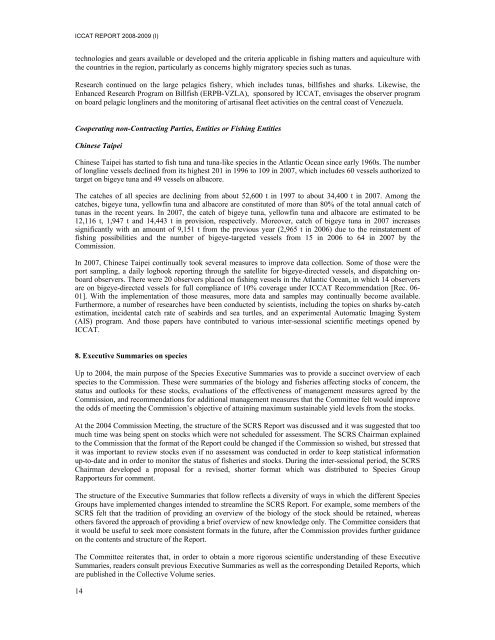REPORT OF THE STANDING COMMITTEE ON RESEARCH ... - Iccat
REPORT OF THE STANDING COMMITTEE ON RESEARCH ... - Iccat
REPORT OF THE STANDING COMMITTEE ON RESEARCH ... - Iccat
Create successful ePaper yourself
Turn your PDF publications into a flip-book with our unique Google optimized e-Paper software.
ICCAT <strong>REPORT</strong> 2008-2009 (I)technologies and gears available or developed and the criteria applicable in fishing matters and aquiculture withthe countries in the region, particularly as concerns highly migratory species such as tunas.Research continued on the large pelagics fishery, which includes tunas, billfishes and sharks. Likewise, theEnhanced Research Program on Billfish (ERPB-VZLA), sponsored by ICCAT, envisages the observer programon board pelagic longliners and the monitoring of artisanal fleet activities on the central coast of Venezuela.Cooperating non-Contracting Parties, Entities or Fishing EntitiesChinese TaipeiChinese Taipei has started to fish tuna and tuna-like species in the Atlantic Ocean since early 1960s. The numberof longline vessels declined from its highest 201 in 1996 to 109 in 2007, which includes 60 vessels authorized totarget on bigeye tuna and 49 vessels on albacore.The catches of all species are declining from about 52,600 t in 1997 to about 34,400 t in 2007. Among thecatches, bigeye tuna, yellowfin tuna and albacore are constituted of more than 80% of the total annual catch oftunas in the recent years. In 2007, the catch of bigeye tuna, yellowfin tuna and albacore are estimated to be12,116 t, 1,947 t and 14,443 t in provision, respectively. Moreover, catch of bigeye tuna in 2007 increasessignificantly with an amount of 9,151 t from the previous year (2,965 t in 2006) due to the reinstatement offishing possibilities and the number of bigeye-targeted vessels from 15 in 2006 to 64 in 2007 by theCommission.In 2007, Chinese Taipei continually took several measures to improve data collection. Some of those were theport sampling, a daily logbook reporting through the satellite for bigeye-directed vessels, and dispatching onboardobservers. There were 20 observers placed on fishing vessels in the Atlantic Ocean, in which 14 observersare on bigeye-directed vessels for full compliance of 10% coverage under ICCAT Recommendation [Rec. 06-01]. With the implementation of those measures, more data and samples may continually become available.Furthermore, a number of researches have been conducted by scientists, including the topics on sharks by-catchestimation, incidental catch rate of seabirds and sea turtles, and an experimental Automatic Imaging System(AIS) program. And those papers have contributed to various inter-sessional scientific meetings opened byICCAT.8. Executive Summaries on speciesUp to 2004, the main purpose of the Species Executive Summaries was to provide a succinct overview of eachspecies to the Commission. These were summaries of the biology and fisheries affecting stocks of concern, thestatus and outlooks for these stocks, evaluations of the effectiveness of management measures agreed by theCommission, and recommendations for additional management measures that the Committee felt would improvethe odds of meeting the Commission’s objective of attaining maximum sustainable yield levels from the stocks.At the 2004 Commission Meeting, the structure of the SCRS Report was discussed and it was suggested that toomuch time was being spent on stocks which were not scheduled for assessment. The SCRS Chairman explainedto the Commission that the format of the Report could be changed if the Commission so wished, but stressed thatit was important to review stocks even if no assessment was conducted in order to keep statistical informationup-to-date and in order to monitor the status of fisheries and stocks. During the inter-sessional period, the SCRSChairman developed a proposal for a revised, shorter format which was distributed to Species GroupRapporteurs for comment.The structure of the Executive Summaries that follow reflects a diversity of ways in which the different SpeciesGroups have implemented changes intended to streamline the SCRS Report. For example, some members of theSCRS felt that the tradition of providing an overview of the biology of the stock should be retained, whereasothers favored the approach of providing a brief overview of new knowledge only. The Committee considers thatit would be useful to seek more consistent formats in the future, after the Commission provides further guidanceon the contents and structure of the Report.The Committee reiterates that, in order to obtain a more rigorous scientific understanding of these ExecutiveSummaries, readers consult previous Executive Summaries as well as the corresponding Detailed Reports, whichare published in the Collective Volume series.14
















